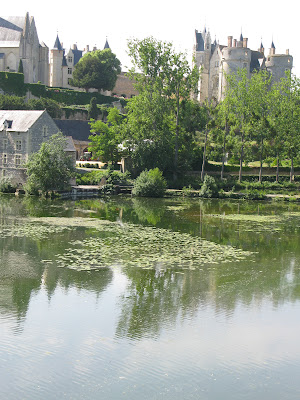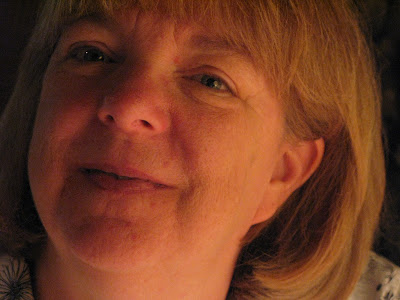We drove to Montreuil-Bellay, about 5 kilometers from Le Puy Notre Dame, to get a closer look at the chateau there and pick up picnic supplies. Chateau de Montreuil-Bellay was built between the 13th and 15th centuries, almost 800 years ago. We’ve seen so many structures of that age on our trip that it’s easy to become desensitized to them, but the history and culture is fascinating to us as Americans when our country is so relatively young. The chateau has served as a medieval fortress with moats, towers, and ramparts, a prison, a residence, even a hospital during World War I.
We stopped for a picnic lunch (just fruit and cheese) in St. Georges sur Layon where there was this beautiful rose-covered arbor. The Saumur region is especially known for its roses. They grow everywhere, seemingly effortlessly and in the worst soil. We have seen them growing in an inch of soil between the sidewalk and the wall of a building, climbing walls and fences, various sizes, varieties, and colors, fragrant and gorgeous. They remind me of the roses of Sonoma County in Dry Creek Valley and Alexander Valley, which are also prolific.
Not far from St. Georges sur Layon we visited a small wine region called Bonnezeaux and Chateau de Fesles. Bonnezeaux is a sub-appellation of the larger Coteaux du Layon which I described in a previous post when we visited Domaine des Baumard. The principal grape of the appellation is Chenin Blanc, which is sensitive to the “noble rot,” Botrytis cinerea, because of the humidity during the autumn. The wines are luscious, honeyed, with citrus and apricot, but with excellent balancing acidity to prevent them from being cloying. They are absolutely delicious as an aperitif or dessert wine, especially with Roquefort or another good bleu cheese. They last for decades and really need at least a few years before opening them to fully appreciate them. We tasted a 2009, 2007, and 2000. They were all wonderful, but with age the flavor character moved from a fresher fruit and honeyed character to a more dried fruit profile, like dried apricots and the candied lemon peel flavor or citron confit.
The grounds of Chateau de Fesles are grand with elaborate gardens and landscaping. Once again, the roses are beautiful.
The nearby town of Brissac-Quincé is home to Chateau de Brissac, described as the tallest castle in France and a partially completed castle inside a partially destroyed castle. The castle has been in the hands of the same family since 1502. The third generation of the family to own the chateau started a rebuilding project which tore down parts of the castle while at the same time building new parts. His idea was to build a higher, symmetrical central section and tear down the medieval towers. He died before the project was completed and his son stopped the work. It has remained in the same unfinished condition for almost 400 years. All that remains of the original castle are the two large towers. It is open to the public, but the family still lives inside the private residence portion of the structure. The current occupants are the eldest son of the 13th Duke de Brissac, the Marquis de Brissac, his wife, and their children. I don’t know how, but they managed to hang onto the property after the Revolution in 1789.
 Many of the furnishings of the chateau are original. The china in the photo on the left dates to the 1700s.
Many of the furnishings of the chateau are original. The china in the photo on the left dates to the 1700s. Dinner was at La Grange a Dime in Montreuil-Bellay. It is quite an interesting place with a single prix fixe menu of a Coteaux du Layon aperitif, mushrooms stuffed with Chèvre, cassoulet with duck confit, café, and dessert. There is no wine list. The wines include the aperitif and a bottle of local, unlabeled Saumur rouge. You go in, you sit down, they bring food and wine, you eat and drink. That’s it. It was fascinating and delicious.
Dinner was at La Grange a Dime in Montreuil-Bellay. It is quite an interesting place with a single prix fixe menu of a Coteaux du Layon aperitif, mushrooms stuffed with Chèvre, cassoulet with duck confit, café, and dessert. There is no wine list. The wines include the aperitif and a bottle of local, unlabeled Saumur rouge. You go in, you sit down, they bring food and wine, you eat and drink. That’s it. It was fascinating and delicious.When Jean-Pierre, apparently the owner, discovered we are American, he rushed away and returned with a framed article from the Wall Street Journal which described the restaurant and food as “French soul food.” He was rightly proud of that article and eager to share it with Americans visiting his restaurant.
 The building that houses the restaurant was originally a barn or an agricultural building where taxed goods were kept, hence the name, La Grange. Serving a single prix fixe menu is pretty specialized, but they are particularly known for an open brick oven and les fouées -- small, hollow breads cooked in the oven, served immediately while piping hot, then stuffed with local Chèvre, butter, and minced pork from ramekins on the table.
The building that houses the restaurant was originally a barn or an agricultural building where taxed goods were kept, hence the name, La Grange. Serving a single prix fixe menu is pretty specialized, but they are particularly known for an open brick oven and les fouées -- small, hollow breads cooked in the oven, served immediately while piping hot, then stuffed with local Chèvre, butter, and minced pork from ramekins on the table.I tasted the pork spread, which reminded me of a spreadable, canned product from my growing up years called potted meat. In fact, the French menu actually describes it as a paté. Mary was a little too timid about stuffing the fouée to suit Jean-Pierre, so he came over to offer some enthusiastic encouragement and assistance. “Plus! Plus!” More! More!
The champignons, the mushrooms, were amazing, stuffed with Chèvre, sprinkled with herbs and pepper, then broiled in the brick oven. They had complex flavors that were savory from the mushrooms, spicy from the pepper, and tangy from the cheese all at once with a texture that was tender on the inside with a little crispness on the outside, just delicious. We want to try this on our grill. Even Mary, who is not a lover of mushrooms, loved these.
 Here’s the main course, the cassoulet, which had the haricots blanc, the white beans, and pulled duck confit, baked to a crusty top with stock and seasonings. A bowl of salad was served alongside, which could accompany the cassoulet or be a separate course.
Here’s the main course, the cassoulet, which had the haricots blanc, the white beans, and pulled duck confit, baked to a crusty top with stock and seasonings. A bowl of salad was served alongside, which could accompany the cassoulet or be a separate course.Here’s my pretty wife at La Grange a Dime in Montreuil-Bellay.
 The Coteaux du Layon aperitif had the golden, honeyed, apricot and citrus sweetness with balancing acidity I described previously. I was interested in how well it paired with the Chèvre, reminding us again that what grows together goes together.
The Coteaux du Layon aperitif had the golden, honeyed, apricot and citrus sweetness with balancing acidity I described previously. I was interested in how well it paired with the Chèvre, reminding us again that what grows together goes together.The bottle of red Saumur did not indicate the producer and I imagine they have a bulk supply and just refill the bottles from night to night. It was not what I would describe as compelling, but it was definitely a Cabernet Franc and reflected the typical structure and style of Saumur. It did just fine with the dinner. I think I might even prefer something like this in a restaurant like this. The focus is on the whole experience with wine as only one part and not the most important part. Here are my notes on the wine.
Lagrange a Dime Saumur unlabeled 2009. This wine is what is served with the prix fixe menu of cassoulet and stuffed mushrooms. It is local but unlabeled other than the name of the restaurant. It was ordinary but quite pleasant. It had dark fruit aromas, currant, nice minerality, smooth texture, medium acidity with nice fruit flavors, smooth tannins. It had nice balance, medium complexity and medium length. Very decent. Alcohol not labeled.
That’s our post for today. We hope you found it interesting and enjoyable. Tomorrow we move to Paris for a couple of days before going home. Keep checking back at Cépage et Cuisine for more of our culinary and wine adventures in France. Until then,
Cheers!
Mary♥Brian






















Hi,
ReplyDeleteI'm French and I'm from Saumur! Though I live near Paris now :-(
I've only read the part about la Grange à Dime and I was thrilled to see you liked it! It's one of my favourite restaurant of fouées! Next time you come try one of those restaurants that are sets in caves (actually what remains of the quarries they exploited to build all these castles)
like this one http://www.cavesdemarson.com/
or this one http://www.cave-aux-moines.com/pages/restaurant.html
Cave-dwelling is quite typical of the region! there you qet to experience the fouées and the cave-dwelling, all in one!
Anyway thank you for visiting my beautiful region. I hope you enjoyed it and will be back soon!
cheers
Nes